Ah, summer. That glorious time of year when the sun seems to have a personal vendetta against your comfort, turning your home into a makeshift sauna. If you’ve ever found yourself tossing and turning at night, sticking to the sofa, or wondering if you should just move into the freezer, you’re not alone. The quest for a cool home during a heatwave is as universal as the British obsession with talking about the weather.
But here’s the good news: you don’t need to choose between comfort and sky-high energy bills. Whether you’re looking for affordable ways to cool your home, want to embrace natural home cooling methods, or simply need summer cooling tips for your house, this guide will walk you through everything you need to know about how to keep your home cool in summer.
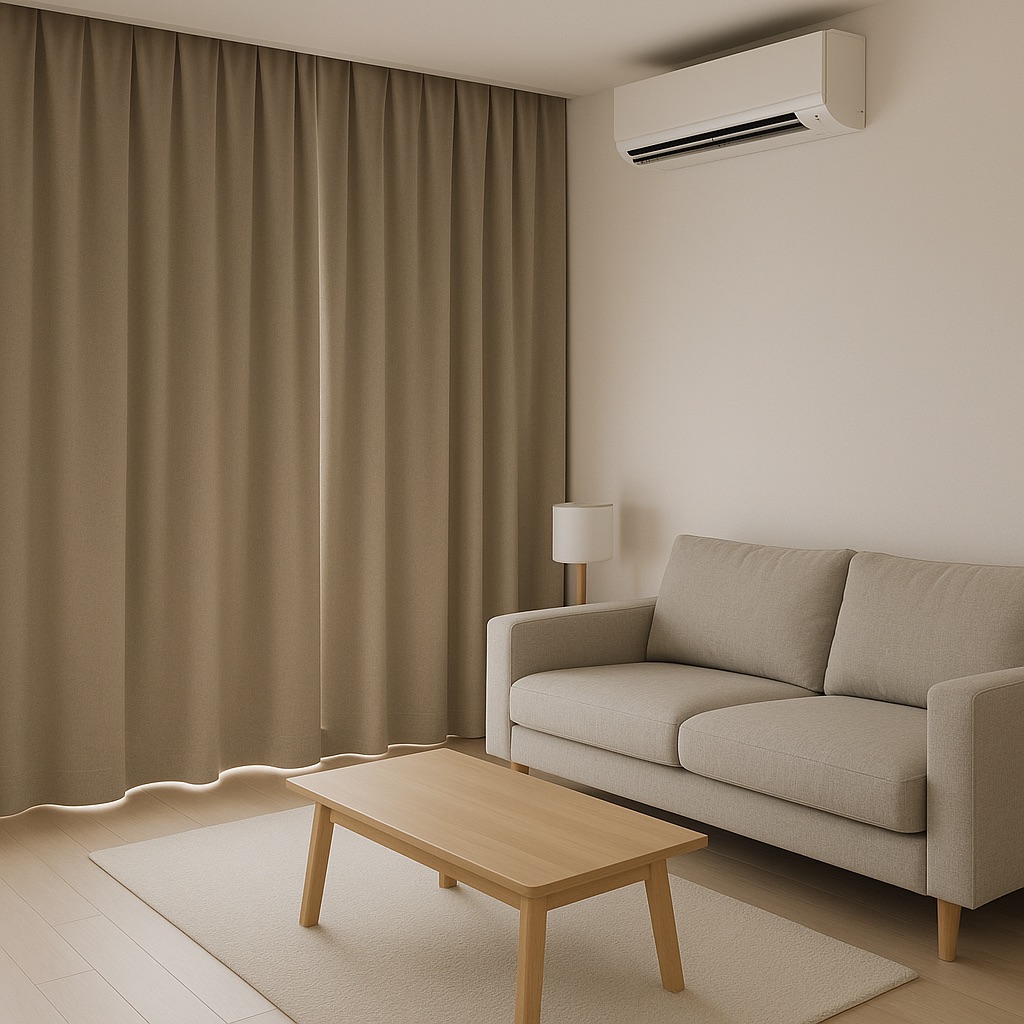
Understanding heat transfer: why does your home get so hot?
Before we leap into solutions, let’s quickly demystify why your home turns into an oven every summer.
Sources of Heat:
- Sunlight through windows: The sun’s rays beam through glass, heating up rooms like a greenhouse.
- Hot outdoor air: Poorly insulated walls, roofs, and gaps around windows and doors let hot air seep in.
- Internal heat sources: Appliances, electronics, and even lighting contribute to rising indoor temperatures.
Basic Principles:
- Insulation: Just as it keeps heat in during winter, good insulation keeps heat out in summer.
- Air circulation: Stagnant air feels hotter. Moving air helps sweat evaporate, cooling your skin.
Understanding these basics is the first step to mastering energy efficient home cooling.
Passive cooling strategies: low or no-cost ways to beat the heat
Who says you need to splurge on air conditioning to stay cool? Some of the best ways to cool a house are also the simplest—and cheapest.
Blocking sunlight
- Curtains, blinds, and shutters:
Keep blinds and curtains closed during the hottest parts of the day, especially on south- and west-facing windows. Blackout or thermal curtains work wonders, but even light-coloured, weighty fabrics can block a surprising amount of heat. - Reflective window film:
A DIY home cooling solution that’s affordable and effective, reflective film can reduce heat and glare by up to 99%. - Shut windows and doors:
It’s counterintuitive, but keeping windows and doors closed during peak heat prevents hot air from sneaking in. Open them only in the early morning or late evening to let in cooler air.
Ventilation: let the breeze in (but only when it’s cool)
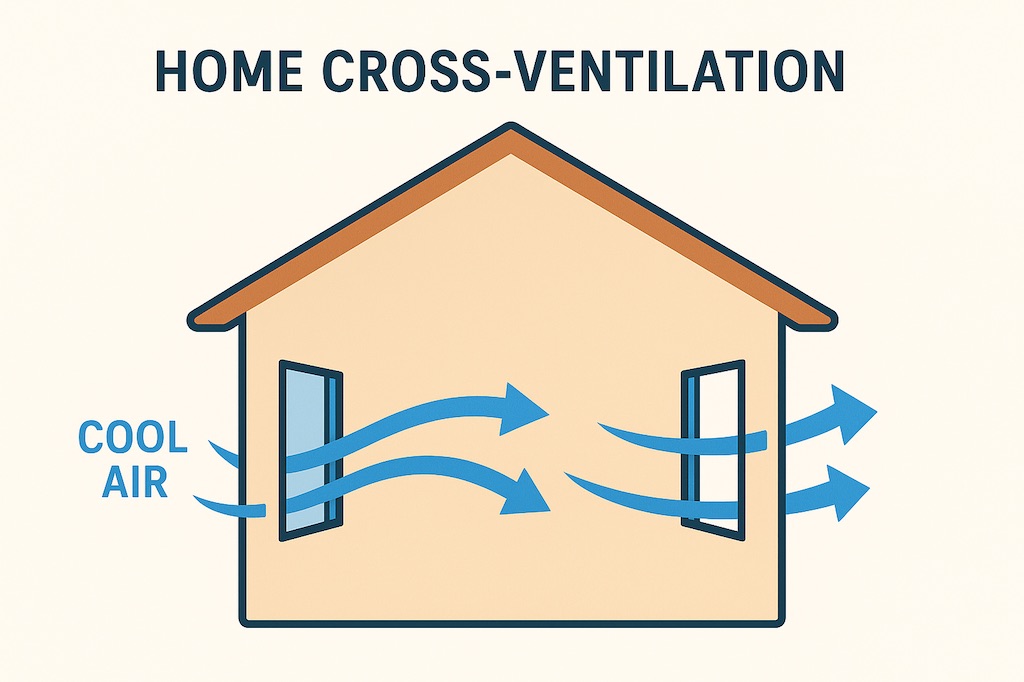
- Cross-ventilation:
Open windows at opposite ends of your home at night or early morning to create a cross-breeze. This natural home cooling method flushes out hot air and brings in the cool. - Fans:
Ceiling fans, pedestal fans, or even a humble desk fan can make a room feel cooler. For a DIY air conditioner, place a bowl of ice in front of a fan to chill the breeze. Remember, fans cool people, not rooms—so turn them off when you leave. - Extractor fans:
Run bathroom and kitchen extractors to remove hot, humid air after cooking or showering. - Close off unused rooms:
Shut doors to rooms you’re not using to prevent them from acting as heat reservoirs.
Reducing internal heat sources
- Limit appliance use:
Ovens, dryers, and even incandescent bulbs generate heat. Cook outside, use the microwave, or meal prep in the evening. Switch to LED lighting to reduce heat and save energy. - Unplug electronics:
Devices on standby still emit heat. Unplug chargers, TVs, and computers when not in use. - Switch to breathable fabrics:
In bedrooms and living areas, use cotton or bamboo bedding and sofa covers. These materials absorb less heat and feel cooler against the skin.
Energy-efficient cooling solutions: moderate cost & DIY upgrades
Ready to invest a little more for lasting comfort? These upgrades offer excellent returns in both coolness and energy savings.
Window treatments
- Reflective films & awnings:
Reflective window films and exterior awnings block solar gain before it enters your home. - Double-glazing:
Upgrading to double-glazed windows improves insulation, keeping heat out in summer and in during winter.
Insulation
- Attic and wall insulation:
Proper insulation is your year-round ally. It keeps hot air out in summer, reducing the need for air conditioning and helping maintain a comfortable indoor temperature. - Floor mats:
Insulating mats can prevent heat from radiating up through floors, especially in homes with sun-exposed flooring.
Weatherstripping and sealing
- Seal gaps:
Use weatherstripping around doors and windows to prevent hot air from sneaking in and cool air from escaping. - Check for drafts:
Even small gaps can make a big difference. Seal cracks and holes in walls, ceilings, and around pipes.
Landscaping for shade
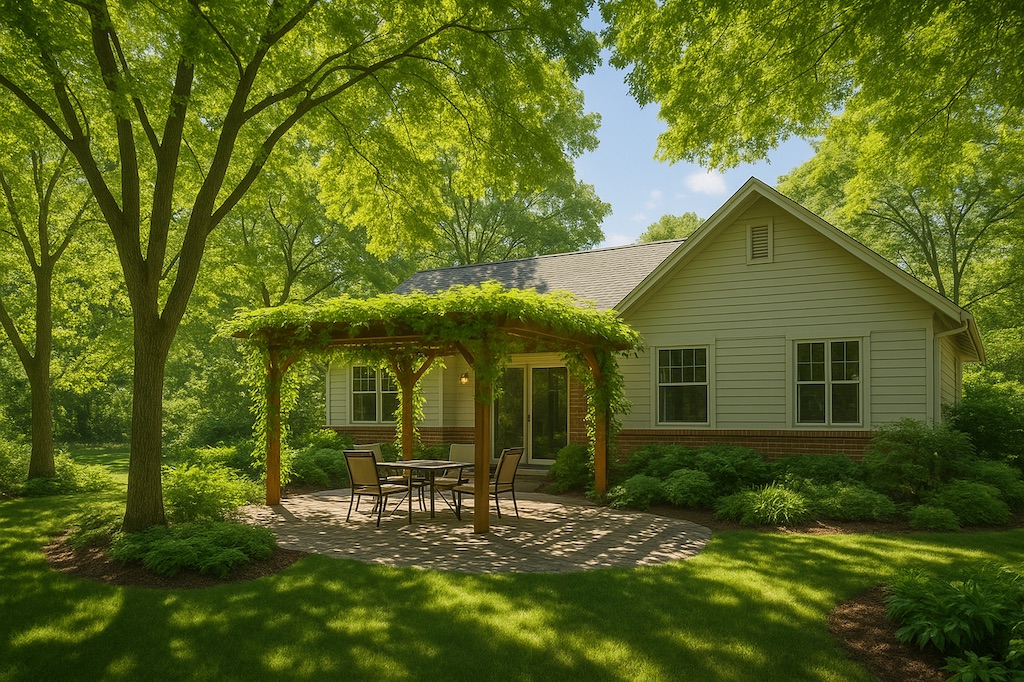
- Plant trees and shrubs:
Strategic planting of deciduous trees or climbing vines can shade your home, especially on the south and west sides. In winter, bare branches let sunlight in, but in summer, lush leaves block the heat. - Green walls and roofs:
For the eco-enthusiasts, living walls and green roofs provide insulation and natural cooling through transpiration.
Smart home cooling devices: the future of effortless comfort
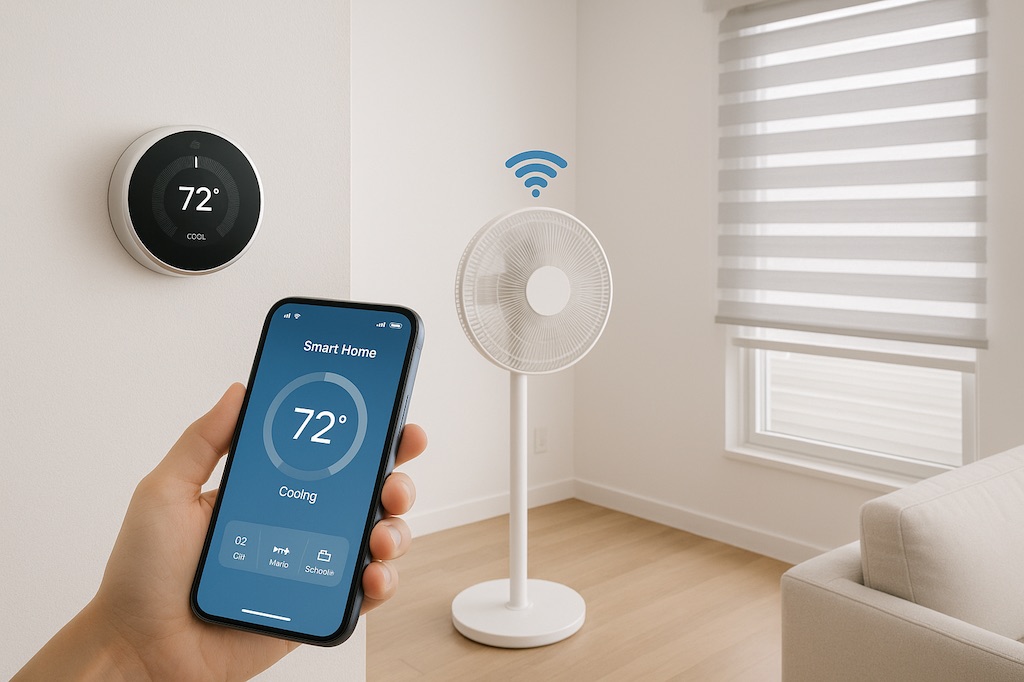
Welcome to the age of intelligent cooling, where your house can outsmart the heat—sometimes before you even realise you’re sweating.
- Smart thermostats:
Devices like the Nest Learning Thermostat or Honeywell T9 learn your schedule, adjust cooling automatically, and can be controlled from your phone or via voice commands. They help maintain comfort while maximising energy savings. - Wi-Fi enabled fans:
Smart tower fans can be controlled remotely via apps or voice assistants like Alexa and Google Home. Set schedules, adjust speeds, and even activate oscillation without leaving your seat—perfect for those “I’m not getting up” moments. - Smart blinds and window coverings:
Automated blinds can be programmed to close during peak sunlight and open when it’s cool, responding to real-time weather data or temperature triggers. Some models integrate with home automation systems, optimising natural light and reducing cooling needs. - Integrated smart home systems:
Advanced setups use sensors to monitor temperature, humidity, and occupancy, automatically adjusting fans, blinds, and cooling systems for maximum efficiency and comfort. - Smart AC controllers:
Devices like Sensibo turn any air conditioner or heat pump into a smart device, letting you control it from anywhere, set schedules, and monitor air quality for a healthier, more energy-efficient home.
Eco-friendly cooling solutions: quick tip box
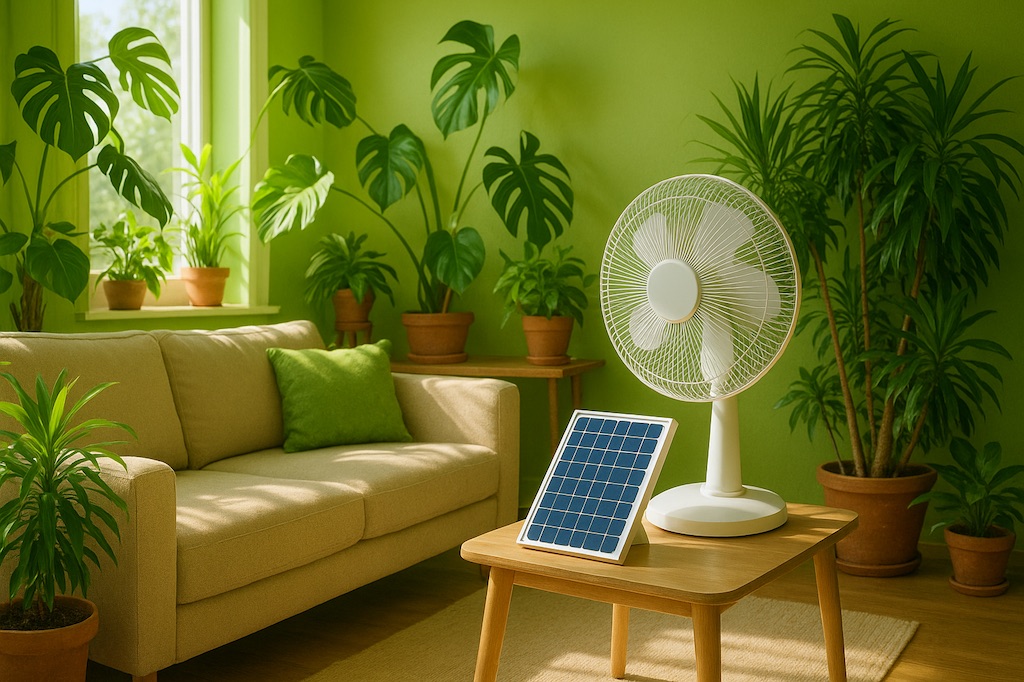
Eco-friendly cooling solutions
- Solar-powered fans: Use the sun’s energy to power desk or window fans—no plug sockets, no guilt.
- Evaporative coolers: These use water evaporation to cool air, consuming far less energy than traditional AC and using no harmful refrigerants.
- Green roofs: A layer of soil and vegetation on your roof insulates your home, reduces heat absorption, and cools the air through evapotranspiration.
- Passive cooling: Utilise cross-ventilation, thermal mass (like stone or brick), and natural shading to keep your home cool without electricity.
- Reflective roofing: Special coatings or materials reflect more sunlight, reducing heat gain.
- Geothermal and solar cooling: Advanced systems harness renewable energy for large-scale, efficient cooling.
- Choose eco-friendly materials: Opt for wood or clay bricks for their superior thermal properties and sustainability.
Advanced cooling systems: high-tech and professional options
If you’re ready to go all-in—or if you live in a region where summer heat is relentless—these options can take your cooling game to the next level.
Air conditioning maintenance
- Service regularly:
Clean or replace filters every 1-3 months to keep your system running efficiently. Dirty filters make your AC work harder, wasting energy and money. - Set thermostats wisely:
Aim for 24–26°C (75–78°F) for a balance of comfort and efficiency. Every degree lower can increase energy use by up to 10%. - Smart thermostats:
Automate your cooling with a smart thermostat. These devices learn your habits, adjust settings for optimal comfort, and can save you up to £100 a year in energy costs. Smart thermostat cooling is a win for both your wallet and the planet.
Alternative cooling systems
- Heat pumps:
Modern heat pumps can cool as well as heat, making them a versatile, energy-efficient choice for year-round comfort. - Evaporative coolers:
Best for dry climates, these devices use water evaporation to cool air, using much less energy than traditional AC. - Ductless mini-splits:
Perfect for homes without existing ductwork, mini-splits offer zoned cooling and high efficiency.
Room-specific tips: tailoring your approach
Not all rooms are created equal when it comes to summer heat. Here’s how to target your efforts for maximum comfort.
Bedrooms: sleep like a baby (not a baked potato)
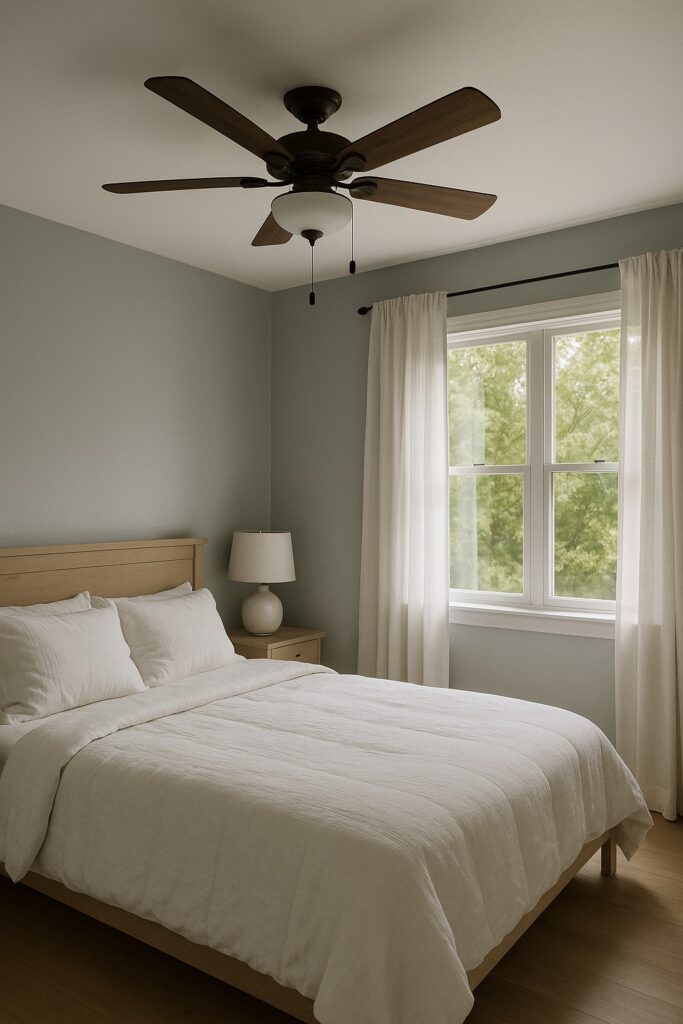
- Use cotton or bamboo bedding:
Light, breathable fabrics help wick away moisture and feel cooler. - Freeze your sheets:
For a quick fix, pop your sheets in the freezer for a few minutes before bed. - Position fans strategically:
Place a fan near an open window at night to draw in cool air, or use a pedestal fan to keep air moving around the bed.
Kitchen & living areas: where the action (and heat) happens
- Cook outside or prepare cold meals:
Keep ovens and stoves off during the day. Fire up the BBQ or enjoy salads instead. - Shut doors during the day:
Contain cool air in the rooms you use most. - Use extractor fans:
Remove excess heat and humidity after cooking or showering.
Common myths and misconceptions: what not to do
Let’s bust a few myths that might be making your home hotter—or your energy bills higher.
- Myth: Opening windows during the day cools your home.
Fact: Unless it’s cooler outside than inside, you’re just letting in more heat. - Myth: Fans cool rooms.
Fact: Fans cool people, not spaces. Turn them off when you leave the room to save energy. - Myth: All insulation is for winter.
Fact: Insulation works both ways, keeping heat out in summer and in during winter. - Myth: More AC is always better.
Fact: Overcooling wastes energy and can cause condensation issues. Set your thermostat to a reasonable temperature.
Seasonal maintenance checklist: get your home summer-ready
Here’s a handy checklist to prep your home for the heat:
- Check and upgrade insulation in attic, walls, and floors.
- Install or repair weatherstripping around windows and doors.
- Clean or replace AC filters.
- Service your air conditioning unit.
- Install reflective window film or thermal curtains.
- Plant shade trees or install awnings.
- Switch to LED lighting.
- Unplug unused electronics.
- Set ceiling fans to run counter-clockwise.
- Stock up on breathable bedding and sofa covers.
- Prepare outdoor spaces for al fresco dining.
Quick heatwave hacks

- Freeze your bedding: Pop your pillowcases or sheets in the freezer for 30 minutes before bed for an instant chill.
- Ice in front of a fan: Place a bowl of ice or frozen water bottles in front of your fan for a refreshing, makeshift air conditioner.
- Close blinds and curtains: Shut blinds, curtains, and doors during the day to block out the sun and keep rooms cooler.
- Damp towels or clothing: Drape a damp, chilled towel around your neck or hang wet towels near a fan to cool the air as it evaporates.
- Soak your feet: Dip your feet in a basin of cold water to quickly lower your core temperature.
- Switch to cotton: Use breathable cotton sheets and clothing for maximum summer comfort.
Conclusion: stay cool, save energy, and enjoy your summer
How to keep your home cool in summer doesn’t have to be a mystery—or a luxury reserved for those with deep pockets and central air. By combining passive strategies, smart upgrades, and a little seasonal savvy, you can reduce heat in your house, boost comfort, and keep your energy bills in check.
Remember, the best ways to cool a house are often the simplest: block the sun, let in cool air when you can, reduce internal heat, and insulate against the elements. Whether you’re looking for natural home cooling methods, affordable ways to cool your home, or high-tech solutions like smart thermostat cooling, there’s a strategy here for every home, budget, and climate.
So, as the mercury rises, why not put these summer cooling tips for your house into practice? Your sleep, your sanity, and your wallet will thank you.
Have your own home cooling hacks? Join the conversation below and share your best tips for staying cool indoors this summer!



